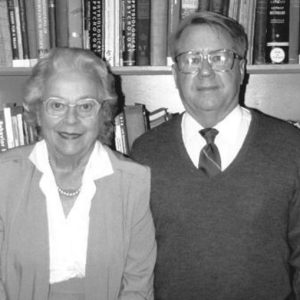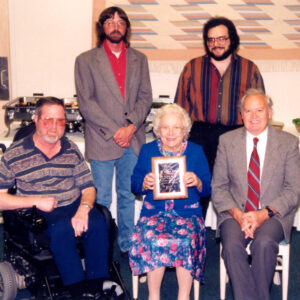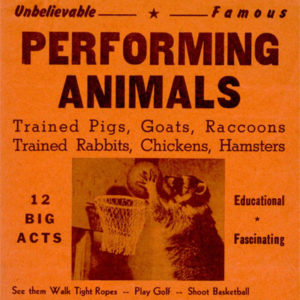calsfoundation@cals.org
Marian Breland Bailey (1920–2001)
Marian (Ruth Kruse) Breland Bailey was a pioneer in the field of animal behavior. Marian and her first husband, Keller Breland, were the first to use operant conditioning technology for commercial purposes. From their Hot Springs (Garland County) farm, the Brelands exported the new technology all over the world.
Marian Ruth Kruse was born on December 2, 1920, in Minneapolis, Minnesota, to Christian and Harriet (Prime) Kruse. Christian Kruse owned an auto parts supply house. Harriet was a registered nurse. Marian had one brother, Donald. She was known as “Mouse” to her friends; Marian’s father was the first to call her “Maus,” a common German term of endearment for girls. Later, when Marian met her soon-to-be husband, Keller, he also called her “Mouse” without knowing her family nickname. The name stuck thereafter. Marian and Keller met in 1938 at the University of Minnesota, and they married in 1941. They had three children.
In the 1930s and 1940s, Marian and Keller Breland worked as research assistants at the University of Minnesota for behavioral psychologist B. F. Skinner. The Brelands and Skinner used positive reinforcement techniques to teach pigeons to guide bombs for the U.S. Navy during World War II. Leaving the University of Minnesota in 1943, the Brelands began the first science-based animal training company, called Animal Behavior Enterprises (ABE), on a farm in Mound, Minnesota.
In 1951, the Brelands moved to a large farm in Hot Springs for the warmer climate. Hot Springs provided a centralized location with nearby rail transportation and, at the time, had a thriving tourist business. In 1955, the Brelands opened the IQ Zoo on Whittington Avenue. It featured wild and domestic animals doing complex tricks; for example, chickens walked a tightrope, danced to music, and played baseball; rabbits kissed their “girlfriends,” rode fire trucks, and spun fortune wheels; ducks played drums and pianos; raccoons played basketball; and reindeer operated a printing press. Later, Bird Brain, the tic-tac-toe-playing chicken, was a feature of the IQ Zoo. The Brelands produced the first operant-trained dolphin show in 1955 (at Marine Studios in St. Augustine, Florida) and the first trained-whale shows in 1957 (at Marine Studios and at Marineland of the Pacific in Palos Verdes, California). They were among the first to use trained animals in television commercials. The Brelands described many of their popular acts “The Misbehavior of Organisms,” a 1961 article in American Psychologist. It is now considered a classic in the field, as is their 1966 text, Animal Behavior.
When Keller died in 1965, Marian became president of ABE. In 1976, she married Bob Bailey, who had been director of marine mammal training for the navy.
Her work extended beyond Arkansas. ABE managed the U.S. Navy Marine Mammal Facility in Key West from 1967 to 1969. With government funding, her company studied dolphin sonar and communication and taught dolphins to assist deep sea divers. Working in the countryside and lakes around Hot Springs, her company of forty skilled technicians guided dogs, cats, gulls, pigeons, and other animals over long distances, using sound, radio, and laser signals. Her technicians even taught ravens to take photographs with small cameras held in their beaks. With her staff, Bailey trained animals of more than 140 species. ABE had worldwide commercial clients, including theme parks, oceanariums, and large companies. ABE animals made appearances on national television shows, such as the Ed Sullivan Show, Today, the Tonight Show with Johnny Carson, Donahue, and the Tomorrow Show. Their work was described in popular magazines. In a 1998 New Yorker article, Calvin Trillin described the antics of one of ABE’s most recognized acts, the tic-tac-toe-playing chicken.
Thirty-one years after leaving the University of Minnesota, Bailey completed her doctorate in psychology at the University of Arkansas (UA) in Fayetteville (Washington County) in 1978. In 1977, she began teaching psychology at Garland County Community College. In 1981, she began teaching at Henderson State University (HSU) in Arkadelphia (Clark County) and retired at age seventy-eight as a full professor. After her retirement, she continued to conduct training workshops with her husband and give lectures throughout the United States and Canada. ABE, Inc., was dissolved as an Arkansas corporation in 1991.
But the importance of Bailey’s work extended beyond animal behavior. She was one of the first psychologists to use positive reinforcement to teach basic self-help skills to persons with mental retardation. Later, she was active in committees on behalf of the Arkadelphia Human Development Center.
Bailey died on September 25, 2001, in Hot Springs. Her ashes were taken to Bush Key, seventy miles west of Key West, Florida, where she often worked with dolphins. Her legacy, in the form of documents and artifacts, is now housed at the Archives of the History of Psychology in Akron, Ohio, and at the Smithsonian Math and Science Museum in Washington DC.
For additional information:
Bailey, R. E., and J. A. Gillaspy, Jr. “Operant Psychology Goes to the Fair: Marian and Keller Breland in the Popular Press, 1947–1966.” The Behavior Analyst 28 (Fall 2005): 143–159.
Breland, K., and M. Breland. “A New Field of Applied Animal Psychology.” American Psychologist 6 (June 1951): 202–204.
———. “The Misbehavior of Organisms.” American Psychologist 16 (November 1961): 681–684.
———. Animal Behavior. New York: Macmillan, 1966.
Gillaspy, J. A., and E. M. Bihm. “Obituary: Marian Breland Bailey (1920–2001).”American Psychologist 57 (April 2002): 292–293.
Marr, John N. “Marian Breland Bailey: The Mouse Who Reinforced.” Arkansas Historical Quarterly 61 (Spring 2002): 59–79.
Elson M. Bihm and J. Arthur Gillaspy, Jr.
University of Central Arkansas
 Marian and Bob Bailey
Marian and Bob Bailey  Marian Breland Bailey Retirement
Marian Breland Bailey Retirement  Keller and Marian Breland with IQ Zoo Rabbit
Keller and Marian Breland with IQ Zoo Rabbit  IQ Zoo Handbill
IQ Zoo Handbill 




Comments
No comments on this entry yet.